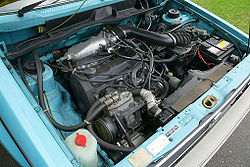VW EA827
| Volkswagen | |
|---|---|
|
EA827, 1.6 l, in a Golf I. |
|
| EA827 | |
| Production period: | 1972-2013 |
| Manufacturer: | Volkswagen |
| Working principle: | Otto |
| Motor design: | Four-cylinder series |
| Valve control: | OHC |
| Displacement: | 1297-1984 cm 3 |
| Mixture preparation: | Carburettor or manifold injection |
| Engine charging: | none or G-Lader |
| Power: | 40-155 kW |
| Previous model: | Audi medium pressure engine |
| Successor: | VW EA113 |
The EA827 (EA = development order) is an engine series of the Volkswagen Group with four cylinders in line and liquid cooling .
The EA827 was developed in 1972 for the Audi 80 and installed in the Audi 80 B1 and VW Passat B1 from 1973 . It was initially available with cubic capacities of 1.3 and 1.5 liters and outputs of 40, 51 and 63 kW. During the production period, the displacement was increased to up to 2 liters. The pitch (distance between the cylinder axes) and the diameter of the crankcase did not allow for a larger displacement. In Germany, when production of the Golf III Cabriolet was discontinued in 2002, the EA827 also ran out, while in China the 1.6-liter variant of the Santana continued to be built until 2013. It was developed under Franz Hauk , the long-standing head of engine design at Audi . The engines of this series are considered to be the most popular engines in the VW Group. The Volkswagen Group's first four-cylinder diesel engines were also based on the EA827 engine block. The EA827 is a water-cooled four-cylinder gasoline engine with cast iron - the engine block , and aluminum countercurrent cylinder head , that is, the inlet and outlet are located on the same side. None of the intake and exhaust ducts are brought together in the cylinder head , so the exhaust manifold and intake pipe are connected with one flange per cylinder. The overhead camshaft is toothed belt driven and actuates the parallel hanging valves via bucket tappets with adjusting plates (shims) that can be removed from above.
later EA 827 with 1.8 l displacement, without cylinder head cover
The gear oil pump of the wet sump lubrication and the ignition distributor are located at the ends of an inclined shaft that is driven by a so-called intermediate shaft via helical gears. The intermediate shaft is in turn driven at half the crankshaft speed via the toothed belt. It sits at the point on the block where the camshaft was on the predecessor, the Audi medium-pressure engine. Originally the engines of the series were equipped with carburettors, later they were converted to manifold injection. In the mid-1970s, the engines were considered powerful, economical, easy-revving and light, so that they were even superior to the BMW M10 engine in some versions of the BMW 114 ( BMW 02 ).
The 827 is also the basis of the five-cylinder EA828 engine, which is a little more rationally designed without an intermediate shaft.
literature
- Volkswagen AutoMuseum Foundation: Generational change. The quantum leap to the new water-cooled ones. Motorbuch-Verlag Stuttgart, ISBN 978-3-613-04245-2 , 1st edition 2019.
Individual evidence
- ↑ Lightweights strike
- ↑ News from the engine. Press release, Volkswagen AG Wolfsburg, February 1991, p. 5
- ↑ a b MNC: Engine History: AUdi's (and VW) EA827 engine - The Inline FOur That Could! , December 9, 2017, accessed July 4, 2018
- ↑ Audi 80 (1972)
- ↑ Restart with number 80 Focus
- ↑ VW Golf Diesel turns 35
- ↑ Dieselboxer runs quietly and calmly ingenieur.de


